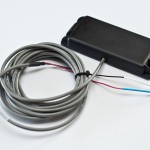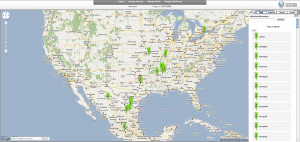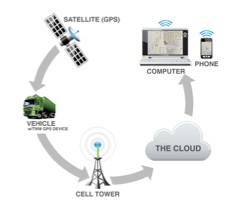Trailer tracking typically describes the process of remotely monitoring the location and status of a large trailer independent of the tractor in a tractor/trailer combination.
There are 4 primary components required to track a trailer:
- Tracking Device
- Communication Network
- Back-End Database and Software
- Software User Interface
Trailer Tracking Components
Tracking Device
GPS tracking devices come in multiple forms. What is common is that all GPS-based trailer tracking devices possess a GPS receiver and a modem by which to communicate. The base function of the tracking device is to acquire the location of the device and transmit that location via a communication network.
Since trailers are routinely exposed to weather and temperature fluctuations, trailer tracking devices must be constructed in a manner that protects the internal electronics from damage. Most gps tracking devices are rated IP67, which means they are waterproof and dust resistant to certain extremes.
Power Sources
Because trailers do not typically have a localized power source (refrigerated trailers excluded), most trailer tracking devices contain an internal battery. The internal battery may be a single-use battery, rechargeable, or replaceable.
Some tracking devices use a hybrid approach to power. These devices install and connect to the trailer wiring system and can take advantage of the tractor’s power source when the trailer is tethered.

Battery/Tethered Trailer Tracking
As a result, these types of devices are capable of sending more frequent messages to the system servers without impacting battery life.
Logic
Many of the current trailer tracking devices on the market can be configured to locate upon a set interval or on events. For instance, a device might be configured to report every day at 5:00 a.m. Another configuration might have the device locate when the trailer leaves a certain geographic boundary.
Or, the devices may be set to locate when the trailer moves. To do this, the devices have motion sensors or accelerometers which detect motion and determine when the device should “wake” to acquire and send location. Differing device manufacturers have different capabilities.
Data Transmission Capabilities
Trailer tracking devices communicate most commonly over a single type of communication network. Though not widely used, due to its limitations, RFID is an option for trailer tracking. The typical drawback to RFID is the requirement of a listening or scanning station to acquire data. As a result, when trailers are away from one of the base stations, they are not track-able.
Otherwise, cellular and satellite are the most common forms of communication. In most cases, high-end tracking solutions will use both cellular and satellite to communicate. However, in more common applications, either cellular or satellite is the dedicated communication method of the device.
Location Methods
Trailer tracking devices most frequently receive location data from the GPS networks. However, some devices are capable of using cellular and wifi data to acquire location information.
Communication Network
Common amongst communication methods is the need to be on a communication network and the ability to transmit data over that network. As a rule, this requires consumers of the data networks to pay a monthly price to the communication network for service and pay an additional amount for data transmission based on the amount of data sent. As a rule, the satellite networks are more expensive.
Cellular Communication
Cellular communication, which is available in almost every country around the world is the most economical form of communication for tracking devices. There are 2 relevant types of cellular communication, GSM and CDMA. A tracking device will normally utilize one or the other. Cellular offers the least expensive method of data transmission and its reliability can be accurately predicted with coverage maps.
Satellite Communication
Satellite communication means that data to be transmitted to the host servers is carried over a satellite network. These are usually low earth orbit networks. Globalstar and Iridum are the most prolific. These satellite networks rely on their network to communicate across the globe. Satellite networks offer coverage in locations not currently served by the cellular networks. This includes remote sites on land as well as the world’s oceans.
Back-End Database and Software
Every GPS tracking system must have software and database capabilities to receive and store tracking data. Commonly, tracking software must decode data from the tracking devices and store those into a database on a server.
Software User Interface
Humans, at some point, are the final consumers of the GPS tracking information. After data is placed in the back-end database, it is transmitted for human use to either a direct user interface or another program which might perform analysis on the data before presenting information to the end user.
The most common delivery form is a map-based tracking software delivered online or via a computer desktop application.  With the proliferation of the Internet, web-based tracking systems are the favorite delivery method for providers looking to track their trailers.
With the proliferation of the Internet, web-based tracking systems are the favorite delivery method for providers looking to track their trailers.
With the proliferation of the iPhone and Android phones, both have become common delivery mechanisms for GPS tracking data.
Many of the tracking applications will interface with ERP and other back office systems. The source tracking system might have a defined API or provide data feeds via XML or other common data delivery mechanisms.
References:


